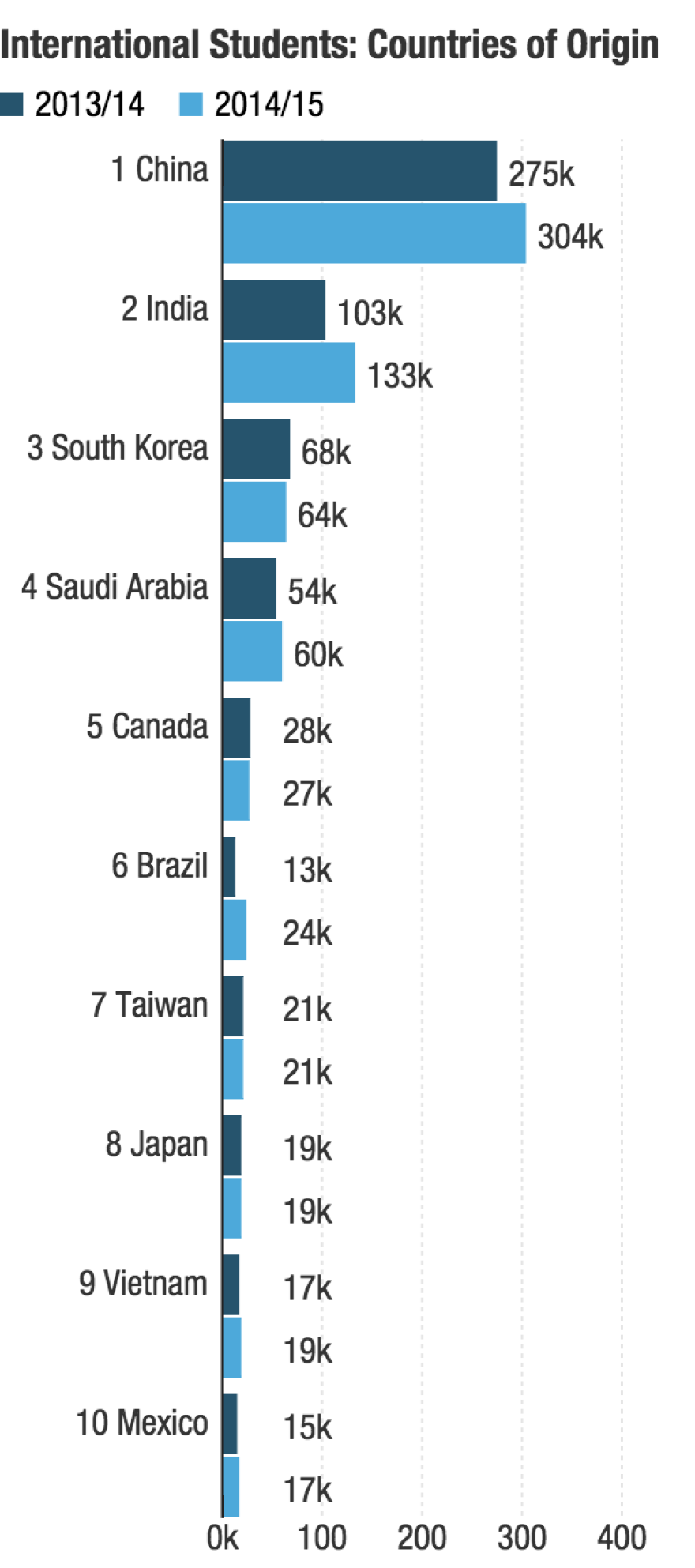The number of international students studying at U.S. colleges and universities jumped last year — in a big way. It's up 10 percent, to roughly 975,000, according to a new report by the Institute of International Education and backed by the State Department.
In 2014-15, China was still the largest source of students with 31 percent of the total. India was in second place with nearly 14 percent. And Indian students were a big reason for the overall jump.

Shreyas Manohar, 21, came from Nagpur — one of India's largest cities — to study at Columbia University, where he's now a sophomore.
Manohar has at least one thing in common with most of his fellow sophomores: He's not sure what he wants to do with his life.
"I'm majoring in creative writing," he says. "And I'm on the fence about economics."
He jokes that it's a choice every international student has to make: "Whether he actually studies what he actually likes, or whether he does something which is practical and which he can tell his parents that is redeemable for a job later."
If Manohar ultimately chooses economics, he'll be in good company. According to the new report, one in five international students comes to the U.S. to study business and management. It's tied with the other top field, engineering.
Why is the U.S. such a popular destination? Its higher education system has long been known for its quality. That reputation has, in the past decade, expanded beyond the Ivy League — and so have many international students, says Allan Goodman, president of the IIE.
"They can get a great education at many institutions in all kinds of climates and settings here in America," Goodman says.
Top U.S. Institutions Hosting International Students, 2014/15
1. New York University — 13,178
2. University of Southern California — 12,334
3. Columbia University — 11,510
4. Arizona State University - 11,330
5. University of Illinois, Urbana-Champaign — 11,223
6. Northeastern University — 10,559
7. Purdue University, West Lafayette — 10,230
8. University of California, Los Angeles — 10,209
9. Michigan State University — 8,146
10. University of Washington — 8,035
There's another reason the U.S. is so attractive. In many countries, a national exam determines every student's future: One bad day, and a student's options can narrow dramatically.

So, Goodman says, many look to the U.S., where "you still have an opportunity to take courses in college and pursue the career of your choice rather than the career that is chosen for you based on your exam results."
Shreyas Manohar is Exhibit A. He says India's exam-based system is a huge barrier — even for many good students.
"You have so much pressure to succeed," he explains, "and because of that, naturally, many people don't do as well as they normally should have."
He considered studying economics at an Indian university but, he says, "to get into the best econ colleges, I needed a 97 or 98 percent on my final exam, and still that wouldn't guarantee my admission."
Instead, Manohar decided to apply to schools in the U.S., where he could study what he wanted and still earn a prestigious degree. But, as is true for many international students, that degree comes with a steep price. Manohar is paying for school without financial aid, he says, "even though that's very tough for my family, and my family has to go through a lot."
According to the IIE report, roughly 80 percent of international undergraduates say personal and family savings are their primary source of education funding. Graduate students have it a little better. That number drops to 55 percent.
The Department of Commerce reports that international students contributed nearly $31 billion to the U.S. economy in the 2014-15 school year.
As for Manohar, he says he figured out the net benefit of earning a degree at Columbia and believes it will pay off in a few years.
Unless he chooses creative writing over economics. That could take a little longer.
Copyright 2020 NPR. To see more, visit https://www.npr.org. 9(MDAyNDY5MjM1MDEyODE2MzMyMTZmZDQwMg001))







